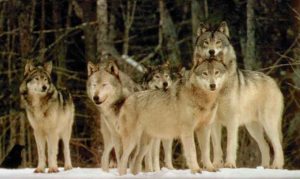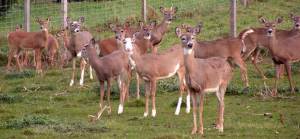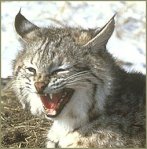
California 01/09/13 wired.com: by Brandon Keim ? An outbreak of a previously unknown virus that causes fatal brain cancer in raccoons has been detected in northern California and southern Oregon. Tumors and the new virus were found in 10 raccoons autopsied between March 2010 and May 2012. Nothing like them had been seen before in raccoons, in which tumors are very rare. There?s no reason to think the virus could be contagious to humans. Its emergence does, however, raise fascinating questions about how it evolved and whether patterns of suburban development actually fueled its rise. ?We need to understand how infectious pathogens are empowered by global  changes,? said veterinary pathologist Patty Pesavento of the University of California, Davis, leader of the team studying the new disease, which was reported in the January issue of Emerging Infectious Disease. ?If there?s a new niche, pathogens will find it.? Nine of the raccoons came from around Marin County, just north of San Francisco, and the 10th was sent from southern Oregon. The raccoons had been spotted wandering in daylight, approaching humans, falling unconscious and generally displaying signs of neurological distress. Tumors appeared to have formed in their olfactory tracts, spread to their frontal lobes and compressed their mid-brains (see picture below). Reviews of scientific literature and calls to veterinary pathologists across North America found no precedents.
changes,? said veterinary pathologist Patty Pesavento of the University of California, Davis, leader of the team studying the new disease, which was reported in the January issue of Emerging Infectious Disease. ?If there?s a new niche, pathogens will find it.? Nine of the raccoons came from around Marin County, just north of San Francisco, and the 10th was sent from southern Oregon. The raccoons had been spotted wandering in daylight, approaching humans, falling unconscious and generally displaying signs of neurological distress. Tumors appeared to have formed in their olfactory tracts, spread to their frontal lobes and compressed their mid-brains (see picture below). Reviews of scientific literature and calls to veterinary pathologists across North America found no precedents.

Patty Pasavento, DVM
In each of the tumors, but not in brain tissue from raccoons tested for comparison, Pesavento?s team found an unknown form of polyomavirus, one of a group of viruses known to cause a rare form of skin cancer in humans and tumors in other animals, including mice and birds. Pesavento?s team called it raccoon polyomavirus. ?The connection between the novel polyomavirus and these raccoon brain tumors is strong,? said disease ecologist Richard Ostfeld of the Cary Institute for Ecosystem Studies, who was not involved in the research. The exact virulence and contagiousness of the new virus is unknown, but there?s reason to think it?s high. Raccoons killed by the tumors accounted for more than one-fifth of all the raccoons Pesavento?s group autopsied between March 2010 and May 2012, and the cases they saw are likely the disease?s tip. Citation: ?Novel Polyomavirus associated with Brain Tumors in Free-Ranging Raccoons, Western United States.? By Florante N. Dela Cruz, Federico Giannitti, Linlin Li, Leslie W. Woods, Luis Del Valle, Eric Delwart, and Patricia A. Pesavento. Emerging Infectious Disease, Vol. 19 No. 1, January 2013. ? For complete article see http://www.wired.com/wiredscience/2013/01/raccoon-cancer-outbreak/
Announcement:
Wolves:
 Washington 01/07/13 wdfw.wa.gov: News Release ? The recovery and management of gray wolves in Washington and other western states will be the topic of three public meetings this month hosted by the Washington Department of Fish and Wildlife (WDFW). A panel of experts will discuss ongoing efforts to recover Washington?s gray wolf population, the latest information from population surveys in Washington and gray wolf management strategies used in other states. ??Wolves are a high-profile species that attract considerable public interest from people who often have opposing views,? said Dave Ware, WDFW game manager. ?This is a great opportunity for people interested in gray wolves to hear from experts about the recovery of the species throughout the West.? Keynote speakers include Mike Jimenez, Rocky Mountain wolf coordinator for the U.S. Fish and Wildlife Service (USFWS) in Wyoming; Carter Niemeyer, retired wolf specialist
Washington 01/07/13 wdfw.wa.gov: News Release ? The recovery and management of gray wolves in Washington and other western states will be the topic of three public meetings this month hosted by the Washington Department of Fish and Wildlife (WDFW). A panel of experts will discuss ongoing efforts to recover Washington?s gray wolf population, the latest information from population surveys in Washington and gray wolf management strategies used in other states. ??Wolves are a high-profile species that attract considerable public interest from people who often have opposing views,? said Dave Ware, WDFW game manager. ?This is a great opportunity for people interested in gray wolves to hear from experts about the recovery of the species throughout the West.? Keynote speakers include Mike Jimenez, Rocky Mountain wolf coordinator for the U.S. Fish and Wildlife Service (USFWS) in Wyoming; Carter Niemeyer, retired wolf specialist  with the USFWS and the U.S Department of Agriculture?s Wildlife Services; and Donny Martorello, WDFW carnivore section manager. ?Lorna Smith, executive director of Western Wildlife Outreach, an independent wild carnivore education organization based in the state of Washington, will moderate the meetings. Each meeting will include an opportunity for the public to submit questions to the presenters about wolf recovery and management. The public meetings are scheduled for:
with the USFWS and the U.S Department of Agriculture?s Wildlife Services; and Donny Martorello, WDFW carnivore section manager. ?Lorna Smith, executive director of Western Wildlife Outreach, an independent wild carnivore education organization based in the state of Washington, will moderate the meetings. Each meeting will include an opportunity for the public to submit questions to the presenters about wolf recovery and management. The public meetings are scheduled for:
- Jan. 16 ? Center Place Regional Event Center, 2426 N. Discovery Place, Spokane Valley, 6-8 p.m.
- Jan. 17 ? Office Building #2, at 14th Ave. and Jefferson St., Olympia, 2:30-5 p.m.
- Jan. 18 ? Magnuson Park?s Garden Room, 7400 Sand Point Way NE, Seattle, 6-8 p.m.
For further details see http://wdfw.wa.gov/news/jan0713a/
Chronic Wasting Disease:
 Iowa 01/08/13 journalexpress.net : by Mark Newman ? News of domesticated deer with chronic wasting disease may become more common. As for the wild deer population, scientists still want assistance. Last week, a third deer in Davis County was revealed to have chronic wasting disease. The state said Pine Ridge hunting preserve cooperated with the Iowa Department of Natural Resources in putting up a fence-inside-a-fence to keep their deer from going nose-to-nose with wild deer. And whenever a client on their preserve successfully hunts a deer, that animal is given over to the DNR for testing. Chronic wasting disease causes deer to lose weight, to stumble around or to act extremely sleepy. It eventually results in death of the deer. DNR deer biologist Tom Litchfield told the Courier Monday there are other illnesses that mimic CWD, but any deer that show such symptoms are tested anyway. Scientists have said CWD is not a danger to humans, even those who eat deer meat ? though they never recommend eating any infected meat. The initial positive sample was confirmed in July, submitted from a deer shot in December 2011. The second positive test was confirmed Dec. 12, 2012, from a deer
Iowa 01/08/13 journalexpress.net : by Mark Newman ? News of domesticated deer with chronic wasting disease may become more common. As for the wild deer population, scientists still want assistance. Last week, a third deer in Davis County was revealed to have chronic wasting disease. The state said Pine Ridge hunting preserve cooperated with the Iowa Department of Natural Resources in putting up a fence-inside-a-fence to keep their deer from going nose-to-nose with wild deer. And whenever a client on their preserve successfully hunts a deer, that animal is given over to the DNR for testing. Chronic wasting disease causes deer to lose weight, to stumble around or to act extremely sleepy. It eventually results in death of the deer. DNR deer biologist Tom Litchfield told the Courier Monday there are other illnesses that mimic CWD, but any deer that show such symptoms are tested anyway. Scientists have said CWD is not a danger to humans, even those who eat deer meat ? though they never recommend eating any infected meat. The initial positive sample was confirmed in July, submitted from a deer shot in December 2011. The second positive test was confirmed Dec. 12, 2012, from a deer  harvested Dec. 1. The fear among state officials and nature enthusiasts is that an infected deer in a pen did or will give the disease to deer in the wilderness. The third sample came from a male deer harvested Dec. 15 at the Pine Ridge Hunting Preserve in Davis County. That brings the number of known infected deer in Iowa from zero six months ago to 13 as of this week. All are from enclosed hunting or breeding facilities. ? For complete article see http://journalexpress.net/community-news-network/x1633446428/Chronic-wasting-disease-sees-fast-rise-in-Iowa
harvested Dec. 1. The fear among state officials and nature enthusiasts is that an infected deer in a pen did or will give the disease to deer in the wilderness. The third sample came from a male deer harvested Dec. 15 at the Pine Ridge Hunting Preserve in Davis County. That brings the number of known infected deer in Iowa from zero six months ago to 13 as of this week. All are from enclosed hunting or breeding facilities. ? For complete article see http://journalexpress.net/community-news-network/x1633446428/Chronic-wasting-disease-sees-fast-rise-in-Iowa
Follow-Up Report:
(See Likely RABID BOBCAT attacks MASSACHUSETTS MAN and his NEPHEW posted 01/08/13)
 Massachusetts 01/09/13 telegram.com: A bobcat that attacked two people in Brookfield on January 6th has tested positive for rabies. A third was exposed to the animal?s blood. All three had already begun receiving post-exposure rabies vaccinations. ? See http://www.telegram.com/apps/pbcs.dll/article?AID=/20130109/NEWS/101099989/1116
Massachusetts 01/09/13 telegram.com: A bobcat that attacked two people in Brookfield on January 6th has tested positive for rabies. A third was exposed to the animal?s blood. All three had already begun receiving post-exposure rabies vaccinations. ? See http://www.telegram.com/apps/pbcs.dll/article?AID=/20130109/NEWS/101099989/1116
Other Rabies Reports:
 Georgia 01/08/13 Fannin County: Health officials confirm four people in Morgantown were exposed to a pet llama that has tested positive for rabies. ? See http://www.foxnews.com/us/2013/01/08/4-people-in-northwest-georgia-exposed-to-rabies-by-pet-llama/
Georgia 01/08/13 Fannin County: Health officials confirm four people in Morgantown were exposed to a pet llama that has tested positive for rabies. ? See http://www.foxnews.com/us/2013/01/08/4-people-in-northwest-georgia-exposed-to-rabies-by-pet-llama/
 Virginia 01/08/13 James City County: A skunk found in the Oakland Subdivision area of the county has tested positive for rabies. ? See http://wtvr.com/2013/01/08/skunk-tests-positive-for-rabies-in-james-city-county/
Virginia 01/08/13 James City County: A skunk found in the Oakland Subdivision area of the county has tested positive for rabies. ? See http://wtvr.com/2013/01/08/skunk-tests-positive-for-rabies-in-james-city-county/
Like this:
Be the first to like this.
arizona immigration law aubrey huff the killers julianne hough brandy michael pineda charles taylor
No comments:
Post a Comment
Note: Only a member of this blog may post a comment.